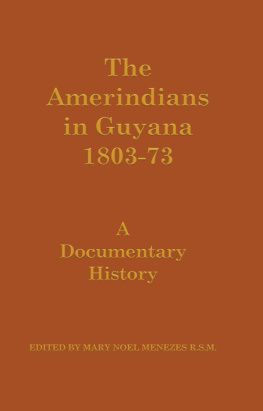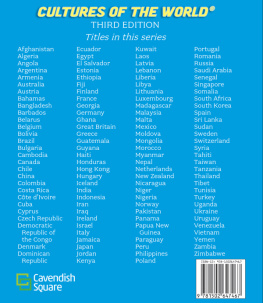The Amerindians in Guyana 180373
First published 1979 by Frank Cass and Company Limited
Published 2019 by Routledge
2 Park Square, Milton Park, Abingdon, Oxon OX14 4RN
52 Vanderbilt Avenue, New York, NY 10017
Routledge is an imprint of the Taylor & Francis Group, an informa business
Copyright 1979 by M. N. Menezes, R.S.M.
All rights reserved. No part of this book may be reprinted or reproduced or utilised in any form or by any electronic, mechanical, or other means, now known or hereafter invented, including photocopying and recording, or in any information storage or retrieval system, without permission in writing from the publishers.
Notice:
Product or corporate names may be trademarks or registered trademarks, and are used only for identification and explanation without intent to infringe.
British Library Cataloguing in Publication Data
The Amerindians in Guyana 180373.
1. Indians of South America Guyana History
Addresses, essays, lectures
I. Menezes, Mary Noel
988.10498F2379
ISBN 13: 978-0-7146-4030-3 (pbk)
To
my family and
community of Sisters, Guyana
I can only inadequately express my warmest thanks to Miss Mary Grant for her unwavering support, and above all, for her time so generously given in furthering this publication. To Dr. Donald Wood for his kind foreword, and to Professors R. A. Humphreys and J. Lynch for their encouragement in compiling the text, I am most grateful. I would also like to record my appreciation for the friendly assistance given me by a wonderful group of people the librarians at the National Archives, Guyana, the Public Record Office, the Rhodes Library, Oxford, the archives of the United Society for the Propagation of the Gospel, the London Missionary Society, the Church Missionary Society, the Jesuits in Guyana and in Farm Street, London.
Unpublished Crown copyright material in the Public Record Office, London, has been used with the kind permission of the Controller, Her Majestys Stationery Office. All other excerpts and documents are published through the courtesy of the National Archives, Guyana, the Jesuit Archives in Guyana and in London, the Rhodes Library, Oxford, and the archives of the United Society for the Propagation of the Gospel, the London Missionary Society, and the Church Missionary Society.
The author gratefully acknowledges the grant from the Isabel Thornley Bequest Fund, University of London, towards the publication of this work.
| B.G.B. | British Guiana Boundary |
| B.M. | British Museum |
| C.M.S.A. | Church Missionary Society Archives CO. Colonial Office Records |
| F.O. | Foreign Office Records |
| J.D.A.G. | Jesuit Diocesan Archives, Guyana |
| J.A.L. | Jesuit Archives, London |
| L.C.G. | Law Courts, Guyana |
| L.B. | Letter Books (in National Archives, Guyana) |
| L.M.S.A. | London Missionary Society Archives |
| M.C.C. | Minutes of the Combined Court |
| M.C.G.B. | Minutes of the Council of Government, Berbice |
| M.C.P. | Minutes of the Court of Policy |
| N.A.G. | National Archives, Guyana |
| P. R. O. | Public Record Office |
| U.S.P.G.A. | United Society for the Propagation of the Gospel Archives |
One of the consequences of decolonisation has been that historians of the West Indies are asking new questions about the past. They no longer find it satisfactory to see the former sugar colonies as mere appendages of the metropolis, their societies judged pale reflections of the imperial light. In the past there were interactions between men in which British colonial policy, important as it may have been, was only part of the story. It is, for example, a modern concern to stop the slaves being treated in the text books mainly as units of labour or as objects of humanitarian pity. Being restored to them is a history and a personality of their own. The immigrants from India and other parts of the Old World are being looked at in a similar way as historians insist that West Indian societies are worthy of study in their own right.
Until now this reassessment has neglected the Amerindian peoples of Guyana, a country which looks seaward to the Caribbean islands, whose fortunes it has for so long shared, and also landward to the untrodden heart of Amazonia. But historians have concentrated on the coast-bound world of sugar in which the Amerindians appeared only fleetingly on the side-lines of events. Their habitat the savannas and the deep forests was formerly shrugged off as inconsequential to the story, and they themselves seemed a people outside history. Yet modern Guyanese writers and artists have sensed that in the ancient and reticent cultures of the Amerindians lie symbols and harmonies which may help to weld the races of Guyana into one nation. They urge in their writings and their art that the aboriginal Indian must be welcomed as an ancestor as well as a citizen of today and tomorrow.
This collection of documents, chosen and annotated by a Guyanese scholar, is the first important contribution to the discovery of the Amerindian past during the nineteenth century. We learn that the Amerindian tribes which found themselves within the boundaries of British Guiana were, in fact, considered to be part of the colony and the responsibility of the government in Georgetown. Colonial administrators tried to work out a native policy just as they did in other parts of the empire; missionaries and planters, officials and speculators all saw the Amerindians in different lights as wayward children deserving education and Christianity, as wards needing protection, as sources of labour or as unwitting pawns in boundary disputes. The Amerindians themselves reacted in different ways to these pressures, and in these documents we sometimes glimpse them as real human beings rather than the depraved or noble savages of European imagination.
This book is important in another way. It is one of the first fruits of the small group of historians at the young University of Guyana. They are working in research and in teaching to explain some of the past moves in the game which have led to the present state of play in Guyana. This collection is a promising start because well chosen documents such as these not only directly illuminate the past but they may teach the student something about the writing of history. The student has the chance, as it were, to inspect an earlier age through a microscope. Events which are compressed into a line or two in a text book open out into something like their full intricacy in a tart exchange of letters or a subtly-worded report. In the records of a controversy, perhaps long since forgotten, he may see for himself something of the complexities and untidiness of life out of which policies were and indeed still are made, and how prejudices were formed or created which still temper his own life.
One must hope that this collection will be followed by others for many seams remain to be worked in discovering the West Indian past.
University of Sussex
Donald Wood
Today the support of minority groups is a fashionable cult. The Amerindians of South America and the Red Indians of North America belong to such a group. Voices are being raised all over the world in defence of the Indian and for his acceptance into a modern society without damage to his culture. In North America the Indian has been roused from his apathy; in the United States of America he is fighting legally for his rights to re-possess his own land; in Canada he is bringing pressure to bear on the government through a nation-wide Association of the National Indian Brotherhood for the solution of his political, social, and economic problems and for the right to preserve his own culture and march to his own drums. In South America the Indian question has not yet evolved so radically, but the Indian is ubiquitous. Population figures compiled by the Aborigines Protection Society in 1972 gave the number of Brazilian Indians as 177,000; in Bolivia, the Summer Institute of Linguistics estimated an approximate 83,000; in Venezuela, 100,000. In Peru and Ecuador the Aymaras and Quechuas constitute an important ethnic group. In Guyana, in the last national census in April 1970 the Amerindians numbered 32,794 out of a total population of 740,196. Their numbers continue to increase.


![Mendi Kuk - A Very Austen Noel [Anthology]](/uploads/posts/book/931765/thumbs/mendi-kuk-a-very-austen-noel-anthology.jpg)








